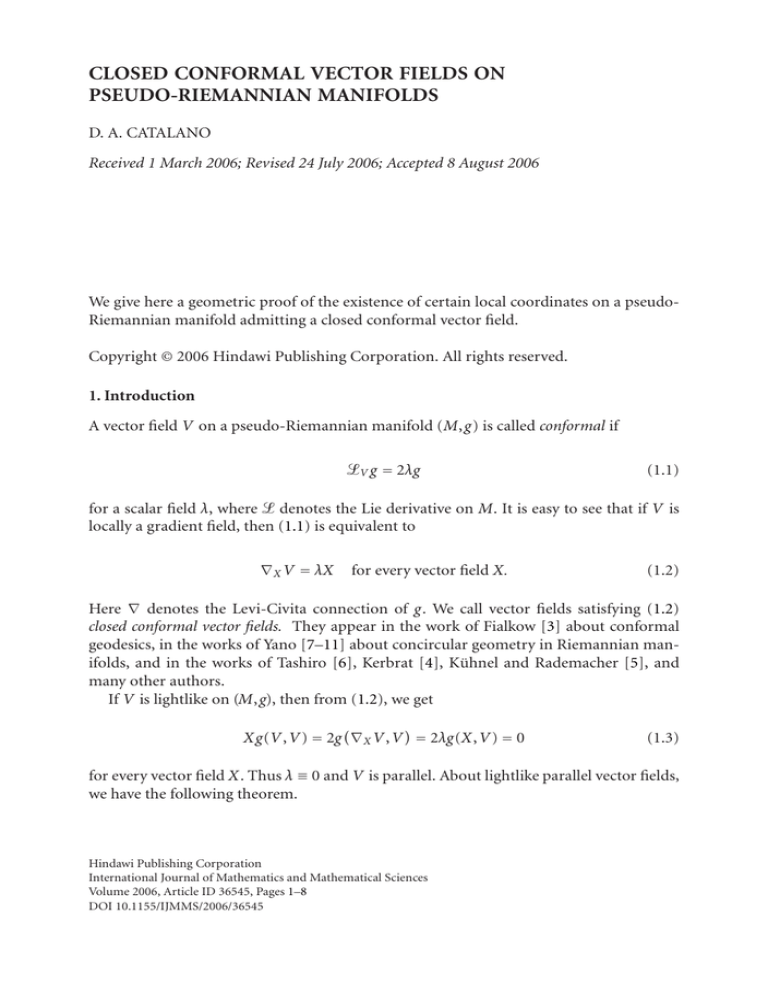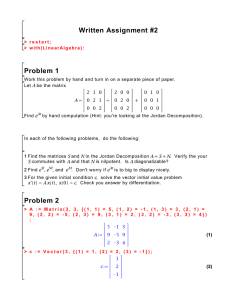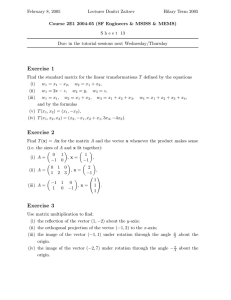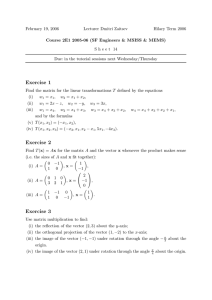
CLOSED CONFORMAL VECTOR FIELDS ON
PSEUDO-RIEMANNIAN MANIFOLDS
D. A. CATALANO
Received 1 March 2006; Revised 24 July 2006; Accepted 8 August 2006
We give here a geometric proof of the existence of certain local coordinates on a pseudoRiemannian manifold admitting a closed conformal vector field.
Copyright © 2006 Hindawi Publishing Corporation. All rights reserved.
1. Introduction
A vector field V on a pseudo-Riemannian manifold (M,g) is called conformal if
ᏸV g = 2λg
(1.1)
for a scalar field λ, where ᏸ denotes the Lie derivative on M. It is easy to see that if V is
locally a gradient field, then (1.1) is equivalent to
∇X V = λX
for every vector field X.
(1.2)
Here ∇ denotes the Levi-Civita connection of g. We call vector fields satisfying (1.2)
closed conformal vector fields. They appear in the work of Fialkow [3] about conformal
geodesics, in the works of Yano [7–11] about concircular geometry in Riemannian manifolds, and in the works of Tashiro [6], Kerbrat [4], Kühnel and Rademacher [5], and
many other authors.
If V is lightlike on (M,g), then from (1.2), we get
Xg(V ,V ) = 2g ∇X V ,V = 2λg(X,V ) = 0
(1.3)
for every vector field X. Thus λ ≡ 0 and V is parallel. About lightlike parallel vector fields,
we have the following theorem.
Hindawi Publishing Corporation
International Journal of Mathematics and Mathematical Sciences
Volume 2006, Article ID 36545, Pages 1–8
DOI 10.1155/IJMMS/2006/36545
2
Closed conformal vector fields on pseudo-Riemannian manifolds
Theorem 1.1 (Brinkmann [2]). If (M,g) admits a lightlike parallel vector field V , then
there are local coordinates u1 ,u2 ,...,un (n := dimM > 2) such that V = ∂/∂u1 and
⎛
gi j
0 1
⎜
⎜ 1 0
⎜
⎜
=⎜
⎜
⎜
⎜
⎝
0
0
0 0
.. ..
. .
0 0
···
···
gαβ
⎞
0
⎟
0 ⎟
⎟
⎟
⎟,
⎟
⎟
⎟
⎠
(1.4)
where α,β ∈ {3,...,n} and ∂gαβ /∂u1 = 0.
Brinkmann’s proof is purely analytical. We will give, in the next section, geometric
tools which will allow us to generalize Brinkmann’s theorem.
2. Geometric constructions
Let (M,g) be a connected pseudo-Riemannian manifold of dimension n and signature
(k,n − k) with 0 < k < n. Given a vector field W on M, we denote by W the one-form
defined by W (X) = g(W,X). Then W is locally a gradient field if and only if dW = 0.
In the following, a vector field W satisfying ∇W W = 0 will be called geodesic.
Lemma 2.1. If W is a geodesic vector field, then dW is invariant under the flow of W.
Proof. Let (∇W )(X,Y ) = (∇X W )(Y ) = g(∇X W,Y ). Then, from the fact that W is geodesic, it follows that
ᏸW ∇W (X,Y ) = Wg ∇X W,Y − g ∇[W,X] W,Y − g ∇X W,[W,Y ]
= g R(W,X)W,Y + g ∇X W, ∇Y W ,
(2.1)
where R denotes the Riemannian curvature tensor,
R(X,Y )Z = ∇X ∇Y Z − ∇Y ∇X Z − ∇[X,Y ] Z.
(2.2)
Since g(R(W,X)W,Y ) is symmetric with respect to X,Y , from
dW (X,Y ) = ∇W (X,Y ) − ∇W (Y ,X),
we get (ᏸW dW )(X,Y ) = (ᏸW ∇W )(X,Y ) − (ᏸW ∇W )(Y ,X) = 0.
Lemma 2.2. If W is a lightlike geodesic vector field, then dW (X,W) = 0.
(2.3)
D. A. Catalano 3
Proof. We have the following.
W lightlike ⇒ (∇W )(X,W) = g(∇X W,W) = 0
⇒ dW (X,W) = 0.
W geodesic ⇒ (∇W )(W,X) = g(∇W W,X) = 0
on a pseudo-Riemannian hypersurface M
can be exA nontangent vector field W
tended to a geodesic vector field W in a neighbourhood of M in the following way. Let
with ċ(0, p) = W(p)
c(s, p) be the geodesic starting at p = c(0, p) ∈ M
and W(c(s, p)) :=
is transversal (i.e. nontangent) to M,
ċ(s, p). Then, taking into account the fact that W
we conclude that W is a geodesic vector field on a neighbourhood of M extending W.
is lightlike, then so is W. Denoting with W
, W
⊥ the tangent and norMoreover, if W
for vector fields X, Y on M
tangent to M,
we have the following
mal component of W,
lemma.
) (X,Y ).
Lemma 2.3. dW (X,Y ) = d(W
⊥ ,Y ) − g(∇Y W
⊥ ,X) = −g(W
⊥ ,[X,Y ]) = 0.
Proof. The statement follows from g(∇X W
The following remark will be used in the proof of the next proposition.
Remark 2.4. Let V be a vector field and let ϕ be a function on M. At a point p0 ∈ M, the
gradient of the solutions of V f = ϕ span an affine hyperplane H of T p0 M. Let v := V (p0 ),
then H = {x ∈ T p0 M | g(x,v) = ϕ(p0 )} and
(a) if ϕ(p0 ) = 0, then H contains lightlike, spacelike, and timelike vectors,
(b) if ϕ(p0 ) = 0, then H contains only lightlike vectors and the zero vector if and only
if n = 2 and v is lightlike.
Proposition 2.5. If V is a closed conformal vector field on (M,g), then in a neighbourhood of a point p0 where V (p0 ) = 0, there is a lightlike geodesic gradient field W such that
g(V ,W) = 1.
Proof. We divide the proof into two cases.
Case 1. n > 2 or n = 2 and V (p0 ) is nonlightlike.
Let u be a solution of V u = 0 with g(p0 )(∇u, ∇u) = 0 (here ∇u denotes the gradient
of u). According to Remark 2.4(b), such a solution exists. Let ᐁ be an open neighbour be the pseudo-Riemannian hypersurface
hood of p0 on which g(∇u, ∇u) = 0, and let M
−1
and, from V u = 0, we have that
u (u(p0 )) ∩ ᐁ. Then ∇u is a normal vector field on M
:= V | is a tangent vector field on M.
Let f : M
→ R be a solution of V
f = 1 such
V
M
that g(p0 )(∇ f , ∇ f ) and g(p0 )(∇u, ∇u) have opposite sign (see Remark 2.4(a)). Without
Setting W
:= ∇ f + h∇u, where
loss of generality, we assume that g(∇ f, ∇ f) = 0 on M.
2
h := −g(∇ f , ∇ f )/g(∇u, ∇u) > 0, we get
W)
= g(∇ f, ∇ f) + h2 g(∇u, ∇u) = 0,
g(W,
f = 1.
, W)
=V
g(V
(2.4)
in a neighbourhood of M.
Then
Let now W be the geodesic vector field extending W
, W)
= 1, we
W is lightlike. From Wg(V ,W) = g(∇W V ,W) + g(V , ∇W W) = 0 and g(V
conclude that g(V ,W) = 1. It remains to show that W is locally a gradient.
4
Closed conformal vector fields on pseudo-Riemannian manifolds
(not necessarily tangent to M),
we can write
For vector fields X,Y on M
X = X + αW,
Y = Y + βW,
(2.5)
and X , Y are tangent to M.
Using Lemma 2.2,
where α and β are certain functions on M
we get
0 = dW (X,W) = dW X + αW,W = dW X ,W .
(2.6)
In the same way, we get dW (W,Y ) = 0, and therefore dW (X,Y ) = dW (X ,Y ).
= ∇ f imply that dW (X,Y ) = 0 on M.
Using Lemma 2.1, we
Now Lemma 2.3 and W
conclude that dW = 0.
Case 2. n = 2 and V (p0 ) is lightlike.
According to Remark 2.4(b), we cannot proceed as in Case 1 since the gradient at p0
of a solution of V u = 0 is a lightlike vector. Remarking that along an integral curve α
:= Imα. Let now W
be a lightlike vector field
of V through p0 V is lightlike, we set M
are linearly independent. Then, since g is nondegenerate,
along α such that V and W
W)
− g(V , W)
2 = −g(V , W)
2 = 0. Therefore we can assume that g(V , W)
=
g(V ,V )g(W,
1. Since W is not tangent to α, we can extend it to a geodesic vector field W on a neigh lightlike, implies W
bourhood ᐁ of p0 . Then Wg(W,W) = 0 which, together with W
= 1, implies
lightlike, and Wg(V ,W) = g(∇W V ,W) = 0 which, together with g(V , W)
g(V ,W) = 1. Since every vector field on ᐁ can be written as a linear combination of V
and W, we have g(∇X W,Y ) − g(∇Y W,X) = 0 for every vector field X, Y on ᐁ if and
only if g(∇V W,W) − g(∇W W,V ) = 0.
Thus W being lightlike and geodesic implies that W is a gradient vector field.
It remains to show that V is lightlike along an integral curve α through p0 := α(0).
This follows from (d/dt)g(V ,V ) = 2g(∇V V ,V ) = 2λg(V ,V ), since its general solution is
t
g(α(t))(V ,V ) = g(p0 )(V ,V )e2 0 λ(u)du .
For example, let M = Rnk be the pseudo-Euclidian space of dimension n and signature
2
< n, that is, x,x = −(x12 + · · · + xk2 ) + (xk+1
+ · · · + xn2 ). The position
(k,n − k) with 0 < k
n
vector field V (x) = i=1 xi (∂/∂xi )|x satisfies ∇X V = X, and therefore it is a closed conformal vector field. We will construct, following the proof of Proposition 2.5, a lightlike geodesic gradient field W with V ,W = 1 in a neighbourhood of a point x0 = 0 (V (x) = 0
if and only if x = 0). We take for simplicity x0 = (1,0,...,0), then u(x1 ,...,xn ) := xn /x1 is
:= u−1 (u(x0 )) = u−1 (0) is
a solution of V u = 0 with ∇u, ∇u|x0 = 1. The hypersuface M
:= V | , then f(x1 ,...,xn−1 ) := lnx1 is a solution of V
f = 1
the hyperplane xn = 0. Let V
M
with ∇ f , ∇ f |x0 = −1. Defining for every x ∈ M that
W(x)
:= ∇ f(x) + ∇u(x) =
∂ 1
∂
,
+
−
x1
∂x1 ∂xn x
(2.7)
it is easy to see that
W(x) :=
∂ 1
∂
−
+
x1 + xn
∂x1 ∂xn x
(2.8)
D. A. Catalano 5
Moreover W is lightlike, V ,W = 1, and
is a geodesic vector field on M extending W.
W = ∇ ln |x1 + xn |. It is clear that W is not unique and not everywhere defined. More
generally, for an arbitrary point x0 = 0, we have, for instance, that
W = ∇ ln a,x,
where a is a lightlike vector in Rnk with a,x0 = 0,
(2.9)
is a lightlike geodesic gradient field satisfying V ,W = 1.
Finally we remark that a nontrivial conformal vector field (a vector field V is nontrivial
if there is a point p ∈ M with V (p) = 0) has isolated zeros (see [4]). This is in general not
true if the conformal vector field is not closed (see, e.g., an example in [1]).
3. Local coordinates
Let V and W be vector fields as in Proposition 2.5 and let E1 = V − g(V ,V )W, E2 = W.
It is easy to see that
(i) E1 , E2 are linearly independent;
(ii) the distribution Ᏸ spanned by E1 , E2 is integrable and the metric g is nondegenerate on Ᏸ;
(iii) the distribution Ᏸ⊥ spanned by the vector fields orthogonal to E1 , E2 is integrable
and g is nondegenerate on Ᏸ⊥ ;
(iv) [E1 ,E2 ] = 0.
We can now state the following theorem.
Theorem 3.1. If (M,g) admits a closed conformal vector field V , then in a neighbourhood of
a point p0 where V (p0 ) = 0, there are local coordinates u1 ,u2 ,...,un such that V = ∂/∂u1 +
a(∂/∂u2 ), for some function a = a(u2 ), and
⎛
−a
⎜
⎜ 1
⎜
⎜
gi j = ⎜
⎜ 0
⎜ ..
⎜ .
⎝
0
1
0
0
..
.
0
0
0
···
···
gαβ
⎞
0
⎟
0 ⎟
⎟
⎟
⎟,
⎟
⎟
⎟
⎠
(3.1)
where α,β ∈ {3,...,n}, det(gαβ ) = 0, and ∂gαβ /∂u1 + a(∂gαβ /∂u2 ) = a gαβ (a := da/du2 ).
Proof. From Frobenius theorem, we know that there are local coordinates u1 ,u2 ,...,un
such that
∂
= E1 ,
∂u1
∂
= E2 ,
∂u2
g1α = g2α = 0,
α = 3,...,n.
(3.2)
6
Closed conformal vector fields on pseudo-Riemannian manifolds
Hence g11 = g(E1 ,E1 ) = g(V ,V ) − 2g(V ,V )g(V ,W) = −g(V ,V ), g12 = g(V ,W) = 1, g22 =
g(W,W) = 0 and, setting Ei = ∂/∂ui , i = 1,...,n, we have that
∂gαβ
∂gαβ
+ a 2 = g ∇E1 Eα + g(V ,V )∇E2 Eα ,Eβ
∂u1
∂u
+ g Eα , ∇E1 Eβ + g(V ,V )∇E2 Eβ
= g ∇Eα E1 + g(V ,V )∇Eα E2 ,Eβ
+ g Eα , ∇Eβ E1 + g(V ,V )∇Eβ E2
(3.3)
= g ∇Eα E1 + g(V ,V )E2 ,Eβ
+ g Eα , ∇Eβ E1 + g(V ,V )E2
= g ∇Eα V ,Eβ + g Eα , ∇Eβ V , = 2λgαβ ,
where a = g(V ,V). From Xg(V ,V) = 2λg(X,V) and g(E1 ,V ) = g(E3 ,V ) = · · · = g(En ,V ) =
0, we conclude that a = a(u2 ). Furthermore
a = Wg(V ,V ) = 2λ
(3.4)
and a = 0 if and only if V is lightlike (cf. with Brinkmann’s theorem).
On the other hand, we have the following proposition.
Proposition 3.2. If on a neighbourhood ᐁ of a point p0 ∈ M, there are local coordinates
as in Theorem 3.1, then V = ∂/∂u1 + a(∂/∂u2 ) is a closed conformal vector field on ᐁ.
Proof. The statement follows from
g ∇Ei V ,E j = g ∇Ei E1 ,E j + a δ2i δ1 j + ag ∇Ei E2 ,E j
∂gi j
1 ∂g1 j ∂gi j ∂g1i
+
−
+ a 2 + a δ2i δ1 j
=
2 ∂ui ∂u1 ∂u j
∂u
=
(3.5)
∂gi j
1 1 ∂gi j
+ a 2 + a δ1i δ2 j + δ2i δ1 j ,
2 ∂u1
∂u
2
where δ is the Kronecker delta. Namely, for every pair (i, j), we get g(∇Ei V ,E j ) =
(1/2)a gi j . Moreover, V is lightlike if and only if a = 0.
Remark 3.3. If in Proposition 3.2 we assume that a = 0, then according to Fialkow results,
see [3, formulas (12.9) and (12.10)], we must be able to prove that (ᐁ,g) is locally isometric to a warped product with a one-dimensional base manifold. This can be seen in
D. A. Catalano 7
the following way: take local coordinates u1 ,...,un in ᐁ such that
∂
∂
1
∂
=
+a 2 ,
∂u
∂u1
|a| ∂u1
∂
∂
=
,
∂u2 ∂u1
∂
∂
=
,
∂uα ∂uα
α = 3,...,n.
(3.6)
This is reached by the coordinate transformation
u1 =
|a|
a
u2 = u1 −
du2 ,
1 2
du ,
a
uα = uα ,
α = 3,...,n.
(3.7)
Then it is easy to see that a = a(u1 ) and that
⎛
g i j := g
∂ ∂
,
∂ūi ∂ū j
⎞
±1
0 0 ··· 0
⎟
−a 0 · · · 0 ⎟
⎟
⎟
⎟.
0
⎟
..
⎟
gαβ
.
⎠
0
⎜
⎜ 0
⎜
⎜
=⎜ 0
⎜ .
⎜ ..
⎝
0
(3.8)
Furthermore, from ∂gαβ /∂u1 + a(∂gαβ /∂u2 ) = a gαβ , we get
∂gαβ
∂gαβ
1 ∂gαβ
1 da
1 da
+a 2 = gαβ =
gαβ ,
1 =
1
2
∂u
∂u
du
a
∂u
du1
|a|
|a|
(3.9)
and therefore gαβ = ag αβ , where ∂g αβ /∂u1 = 0. Thus (ᐁ,g) is locally isometric to a warped
product with a one-dimensional base manifold and warped factor a. In these local coordinates, the metric of the fiber manifold is given by
⎛
−1
⎜
⎜ 0
⎜ .
⎜ .
⎝ .
0
···
g αβ
0
⎞
⎟
⎟
⎟
⎟
⎠
(3.10)
0
which means, in other words, that u2 ,...,un are Fermi coordinates on the fiber manifold.
Acknowledgment
The author wishes to thank Professor K. Voss of the Swiss Federal Institute of Technology
in Zurich for helpful suggestions on the subject.
References
[1] D. Alekseevski, Self-similar Lorentzian manifolds, Annals of Global Analysis and Geometry 3
(1985), no. 1, 59–84.
[2] H. W. Brinkmann, Einstein spaces which are mapped conformally on each other, Mathematische
Annalen 94 (1925), no. 1, 119–145.
[3] A. Fialkow, Conformal geodesics, Transactions of the American Mathematical Society 45 (1939),
no. 3, 443–473.
8
Closed conformal vector fields on pseudo-Riemannian manifolds
[4] Y. Kerbrat, Transformations conformes des variétés pseudo-riemanniennes, Journal of Differential
Geometry 11 (1976), no. 4, 547–571.
[5] W. Kühnel and H.-B. Rademacher, Essential conformal fields in pseudo-Riemannian geometry,
Journal de Mathématiques Pures et Appliquées. Neuvième Série 74 (1995), no. 5, 453–481.
[6] Y. Tashiro, Complete Riemannian manifolds and some vector fields, Transactions of the American
Mathematical Society 117 (1965), 251–275.
[7] K. Yano, Concircular geometry III. Theory of curves, Proceedings of the Imperial Academy of
Tokyo 16 (1940), 442–448.
, Concircular geometry IV. Theory of subspaces, Proceedings of the Imperial Academy of
[8]
Tokyo 16 (1940), 505–511.
, Concircular geometry. I. Concircular transformations, Proceedings of the Imperial Acad[9]
emy of Tokyo 16 (1940), 195–200.
, Concircular geometry. II. Integrability conditions of ρμν = ϕgμν , Proceedings of the Impe[10]
rial Academy of Tokyo 16 (1940), 354–360.
, Concircular geometry. V. Einstein spaces, Proceedings of the Imperial Academy of Tokyo
[11]
18 (1942), 446–451.
D. A. Catalano: Departamento de Matemática, Universidade de Aveiro, Campus de Santiago,
3810-193 Aveiro, Portugal
E-mail address: domenico@mat.ua.pt





